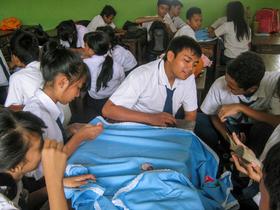For the 2025-26 school year, there is 1 public preschool serving 396 students in 53555, WI.
Public preschools in zipcode 53555 have a diversity score of 0.15, which is less than the Wisconsin public preschool average of 0.59.
Minority enrollment is 8% of the student body (majority Hispanic), which is less than the Wisconsin public preschool average of 38% (majority Hispanic and Black).
Best 53555, WI Public Preschools (2025-26)
School
(Math and Reading Proficiency)
(Math and Reading Proficiency)
Location
Quick Facts
Rank: n/an/a
1307 Sauk St
Lodi, WI 53555
(608) 592-3855
Lodi, WI 53555
(608) 592-3855
Gr: PK-2 | 396 students Student-teacher ratio: 17:1 Minority enrollment: 8%
53555, Wisconsin Public Schools (Closed)
School
Location
Quick Facts
Gibraltar Charter School (Closed 2015)
Charter School
1100 Sauk St
Lodi, WI 53555
(608) 592-3853
Lodi, WI 53555
(608) 592-3853
Gr: 9-10 | 5 students Student-teacher ratio: 5:1
103 Pleasant St
Lodi, WI 53555
(608) 592-3855
Lodi, WI 53555
(608) 592-3855
Gr: PK | 85 students Student-teacher ratio: 28:1 Minority enrollment: 18%
222 W Pearl St
Lodi, WI 53555
(608) 583-2091
Lodi, WI 53555
(608) 583-2091
Gr: PK-5 | 70 students Student-teacher ratio: 9:1 Minority enrollment: 11%
Frequently Asked Questions
How many public preschools are located in 53555, WI?
1 public preschools are located in 53555, WI.
What is the racial composition of students in 53555?
53555 public preschools minority enrollment is 8% of the student body (majority Hispanic), which is less than the Wisconsin public preschools average of 38% (majority Hispanic and Black).
Recent Articles

Charter Schools vs Public Schools 2025: Key Differences & Trends
Explore updated 2025 insights comparing charter schools vs public schools, enrollment, academic outcomes, funding, and real-world examples for families and educators.

Are Public Schools Ready for the 21st Century? 2025 Update
Explore 2025 insights on whether public schools are ready for the 21st century, covering performance, technology, equity, funding, and future-ready learning.

Public School Open House & Enrollment Season Guide
A parent-focused guide to the public school open house and enrollment season, with expert questions, timelines, and decision tips.
